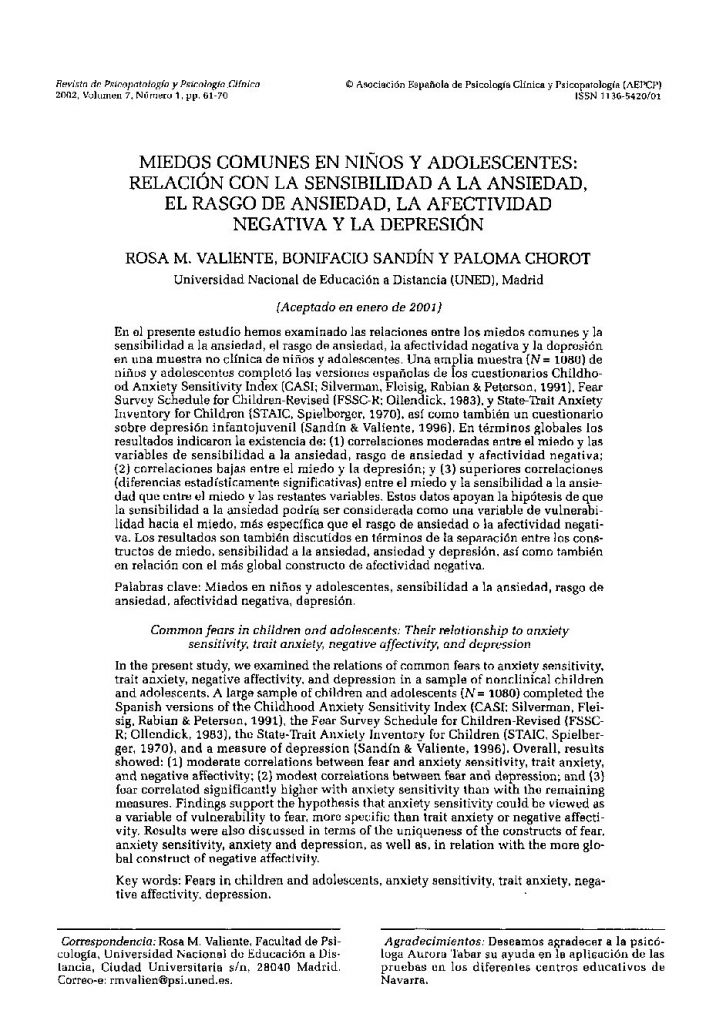Miedos comunes en niños y adolescentes: Relación con la sensibilidad a la ansiedad, el rasgo de ansiedad, la afectividad negativa y la depresión.

- Papel de las emociones negativas en el trastorno cardiovascular: Un análisis crítico.
- Los perfiles interpersonales: Aspectos clínicos del circumplex interpersonal de Wiggins.
- Alexitimia y características psicológicas asociadas a actitudes alimentarias en una muestra de adolescentes.
- Memoria automática preservada en esquizofrenia mediante el procedimiento de disociación de procesos.
- Miedos comunes en niños y adolescentes: Relación con la sensibilidad a la ansiedad, el rasgo de ansiedad, la afectividad negativa y la depresión.
In the present study, we examined the relations of common fears to anxiety sensitivity, trait anxiety, negative affectivity, and depression in a sample of nonclinical children and adolescents. A large sample of children and adolescents (N = 1080) completed the Spanish versions of the Childhood Anxiety Sensitivity Index (CASI; Silverman, Fleisig, Rabian & Peterson, 1991), the Fear Survey Schedule for Children-Revised (FSSC-R; Ollendick, 1983), the State-Trait Anxiety Inventory for Children (STAIC, Spielberger, 1970), and a measure of depression (Sandín & Valiente, 1996). Overall, results showed: (1) moderate correlations between fear and anxiety sensitivity, trait anxiety, and negative affectivity; (2) modest correlations between fear and depression; and (3) fear correlated significantly higher with anxiety sensitivity than with the remaining measures. Findings support the hypothesis that anxiety sensitivity could be viewed as a variable of vulnerability to fear, more specific than trait anxiety or negative affectivity. Results were also discussed in terms of the uniqueness of the constructs of fear, anxiety sensitivity, anxiety and depression, as well as, in relation with the more global construct of negative affectivity.
En el presente estudio hemos examinado las relaciones entre los miedos comunes y la sensibilidad a la ansiedad, el rasgo de ansiedad, la afectividad negativa y la depresión en una muestra no clínica de niños y adolescentes. Una amplia muestra (N = 1080) de niños y adolescentes completó las versiones españolas de los cuestionarios Childhood Anxiety Sensitivity Index (CASI; Silverman, Fleisig, Rabian & Peterson, 1991), Fear Survey Schedule for Children-Revised (FSSC-R; Ollendick, 1983), y State-Trait Anxiety Inventory for Children (STAIC, Spielberger, 1970), así como también un cuestionario sobre depresión infantojuvenil (Sandín & Valiente, 1996). En términos globales los resultados indicaron la existencia de: (1) correlaciones moderadas entre el miedo y las variables de sensibilidad a la ansiedad, rasgo de ansiedad y afectividad negativa; (2) correlaciones bajas entre el miedo y la depresión; y (3) superiores correlaciones (diferencias estadísticamente significativas) entre el miedo y la sensibilidad a la ansiedad que entre el miedo y las restantes variables. Estos datos apoyan la hipótesis de que la sensibilidad a la ansiedad podría ser considerada como una variable de vulnerabilidad hacia el miedo, más específica que el rasgo de ansiedad o la afectividad negativa. Los resultados son también discutidos en términos de la separación entre los constructos de miedo, sensibilidad a la ansiedad, ansiedad y depresión, así como también en relación con el más global constructo de afectividad negativa.



